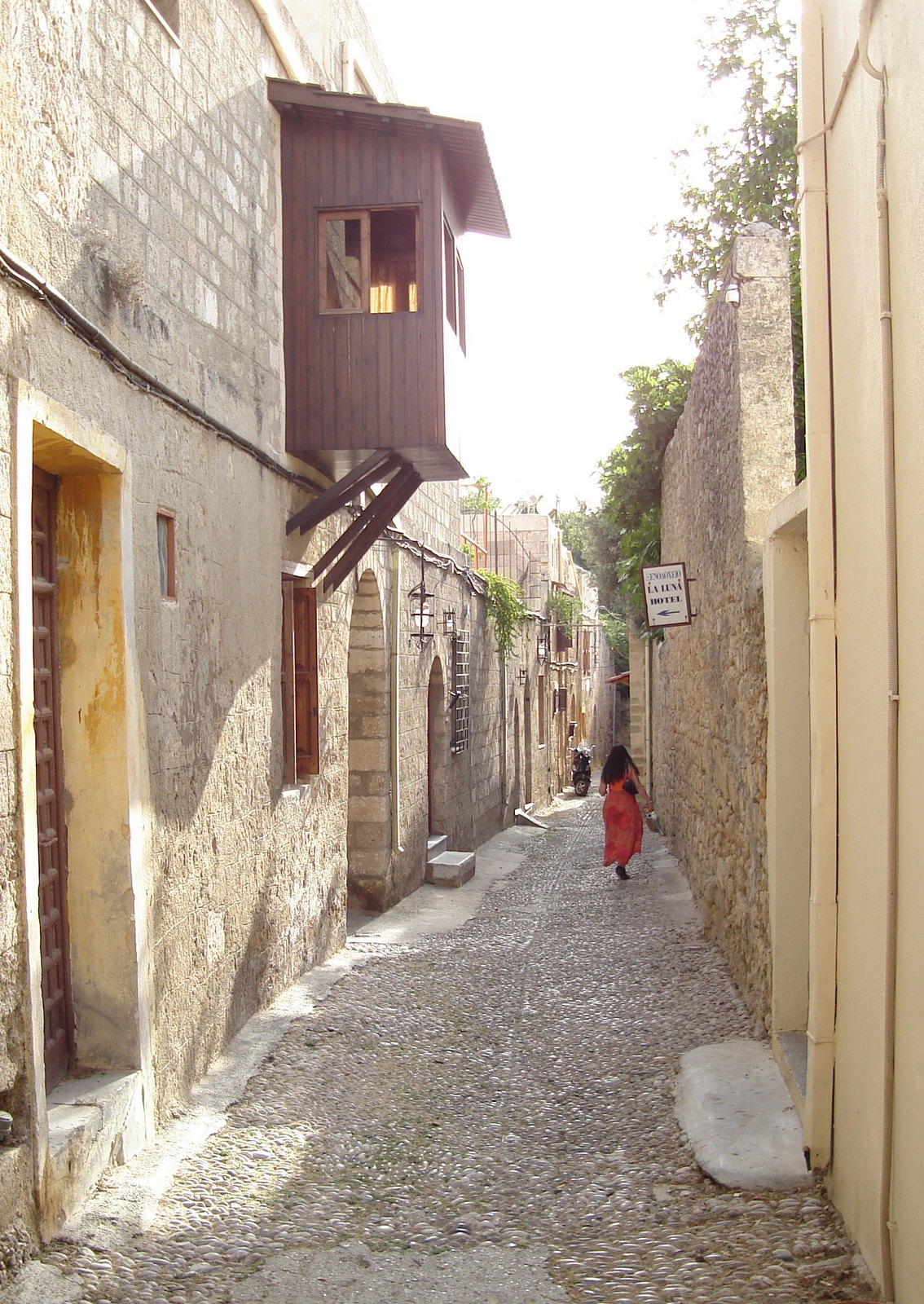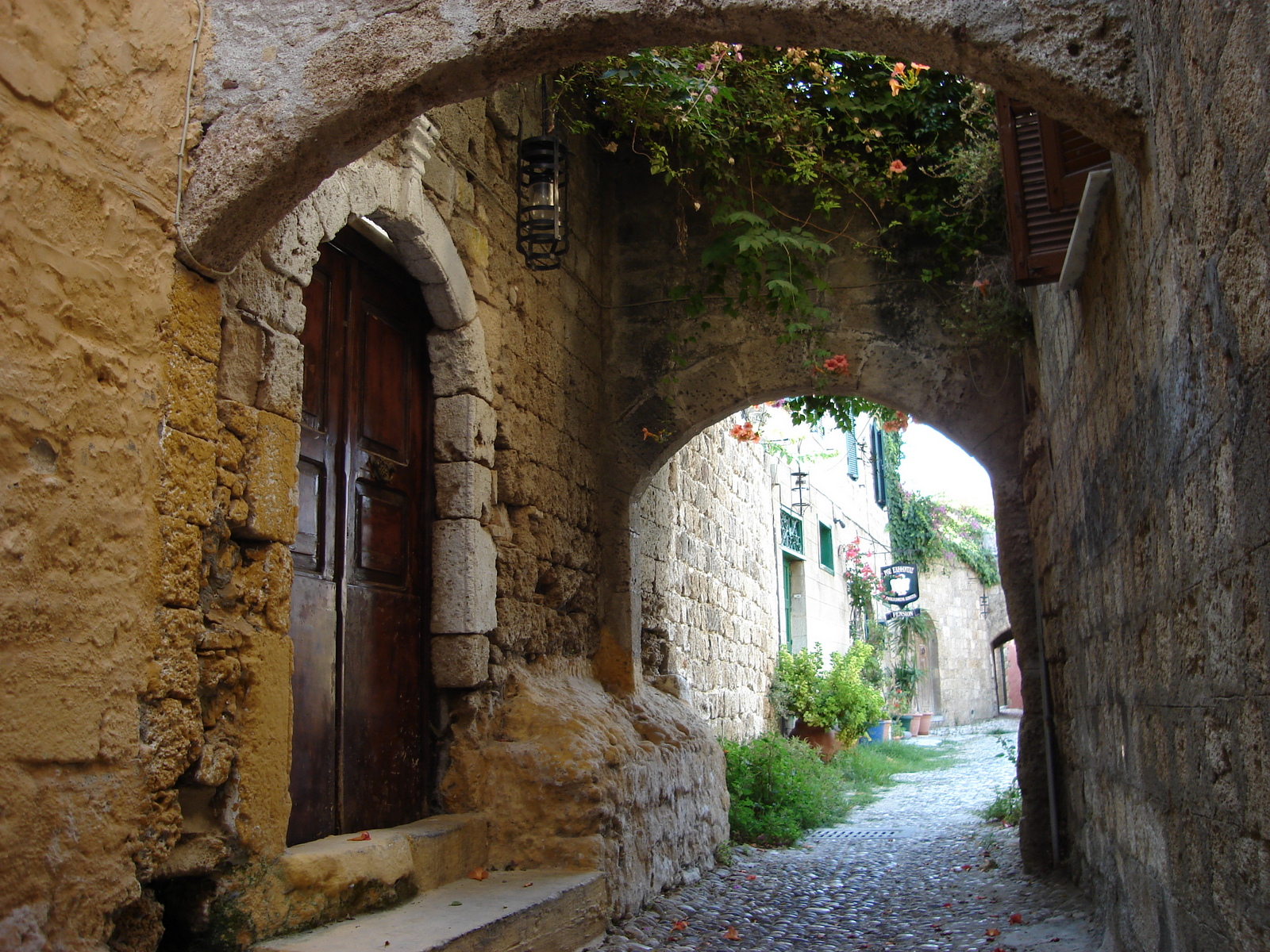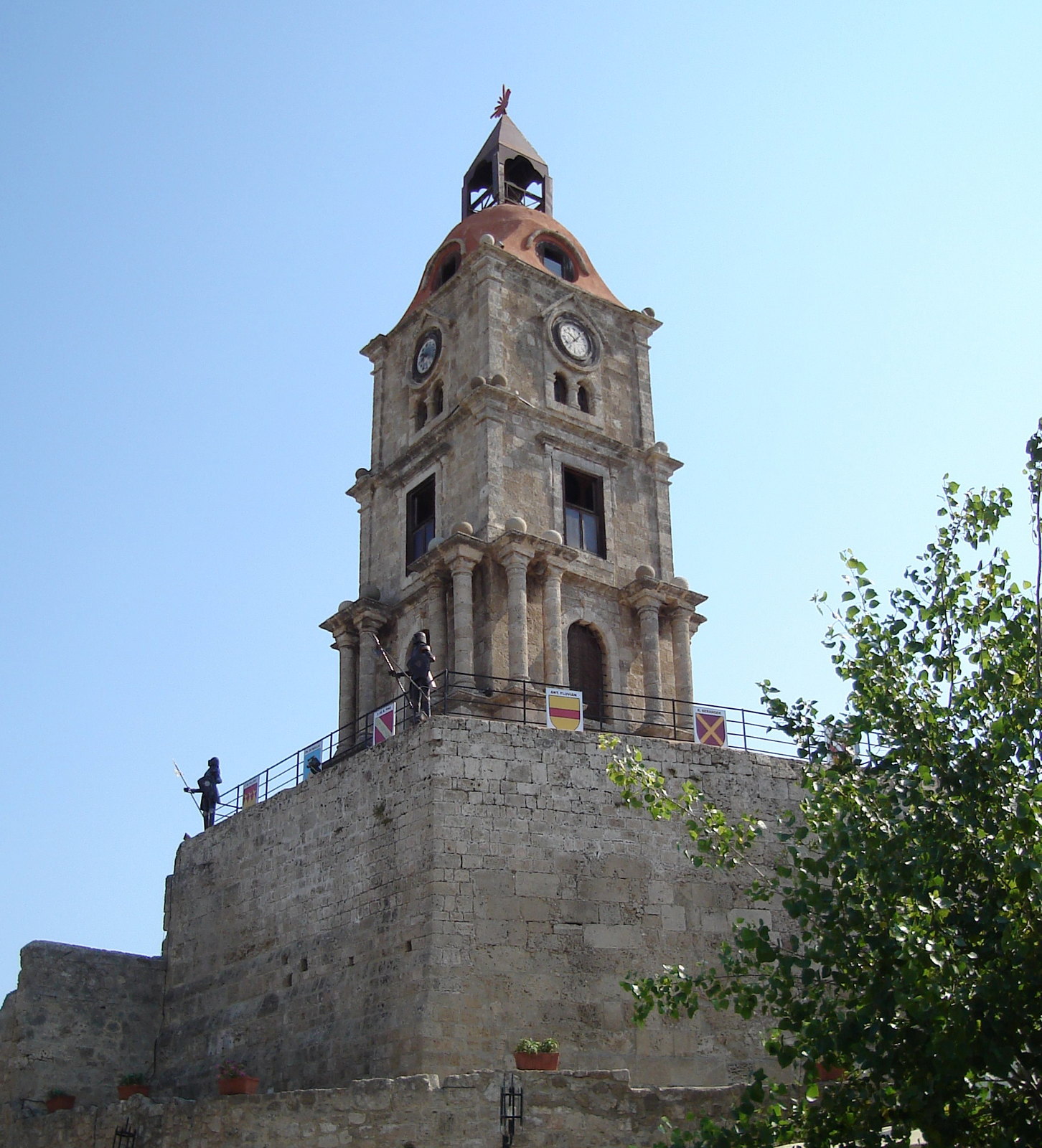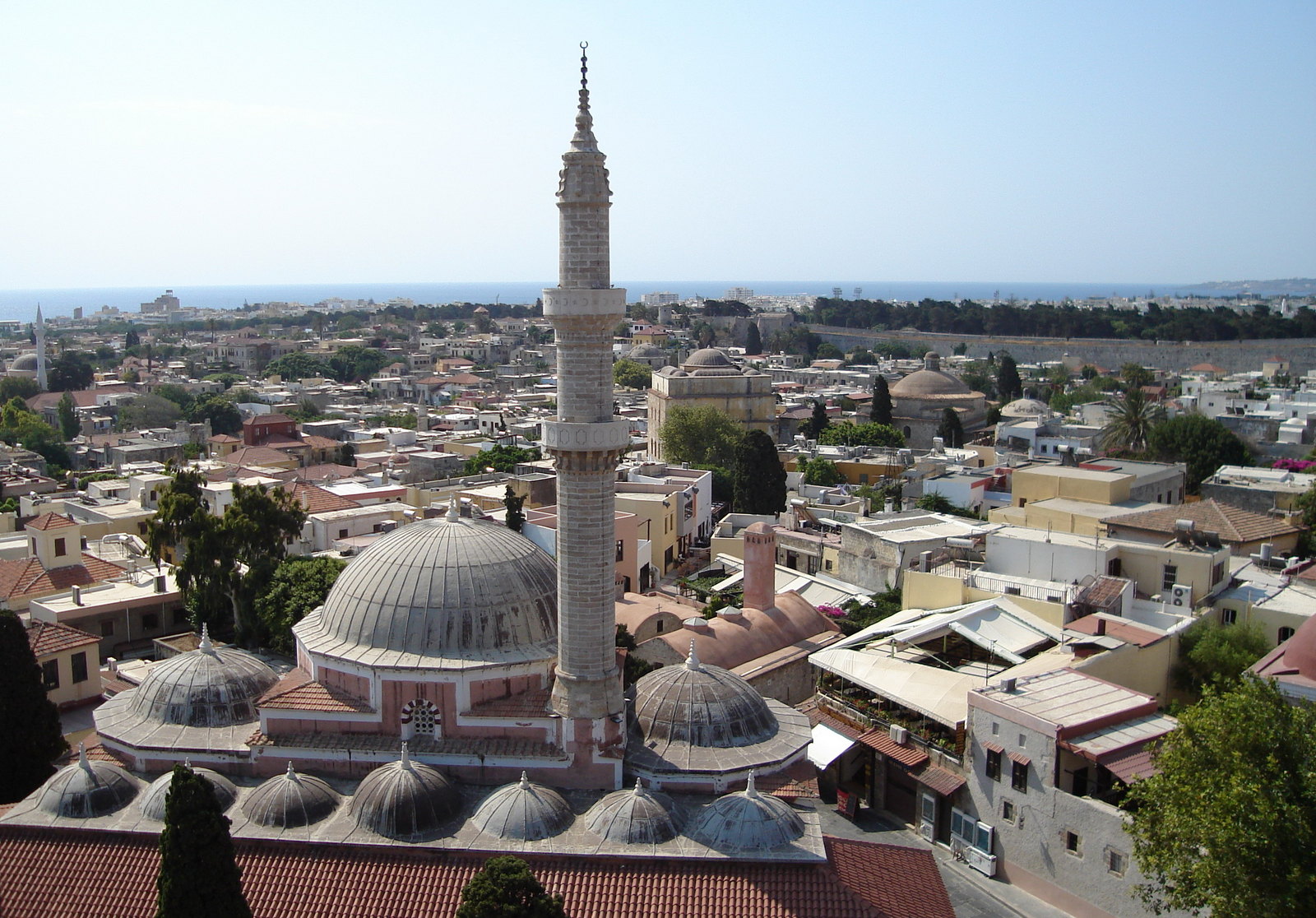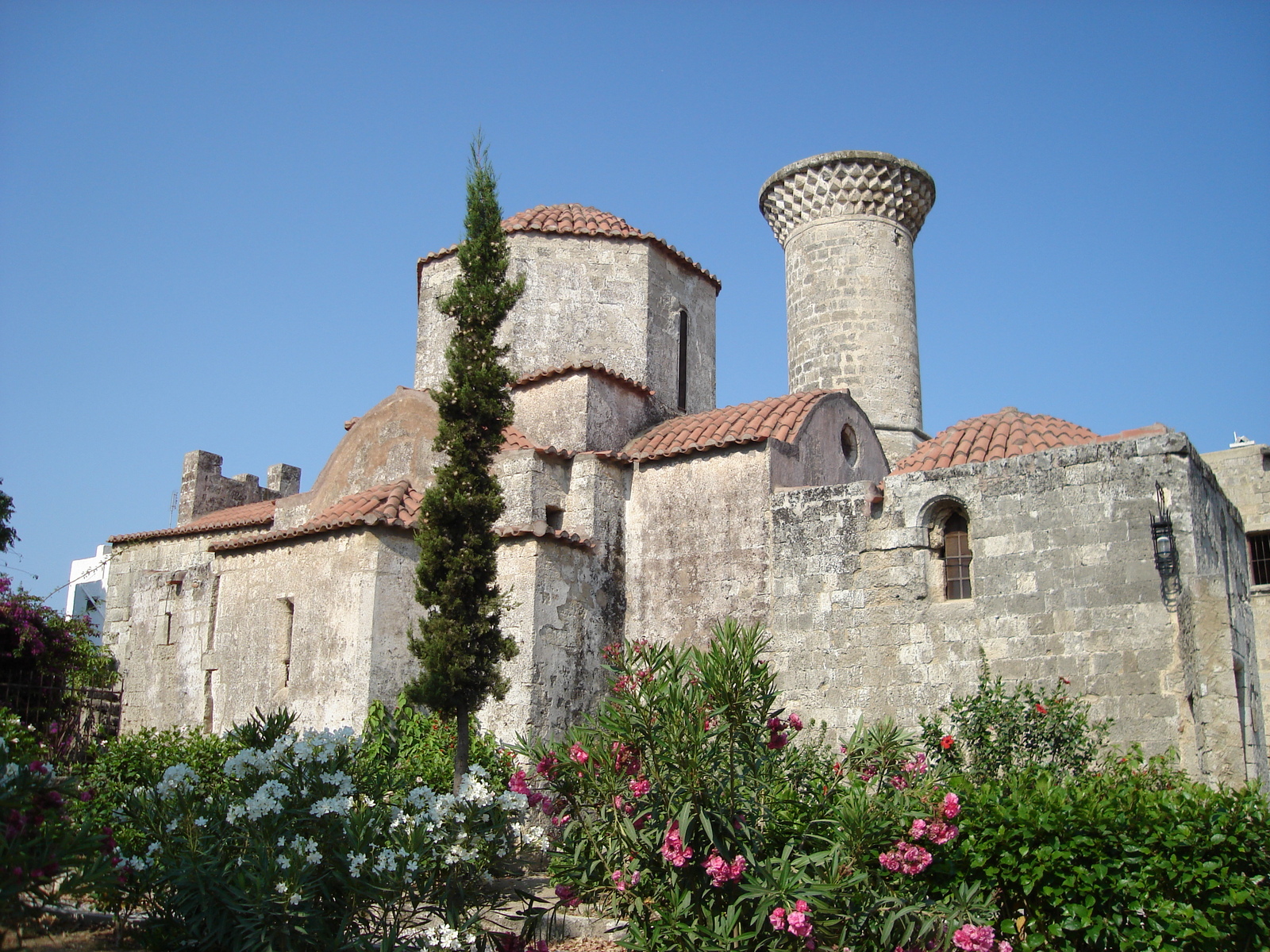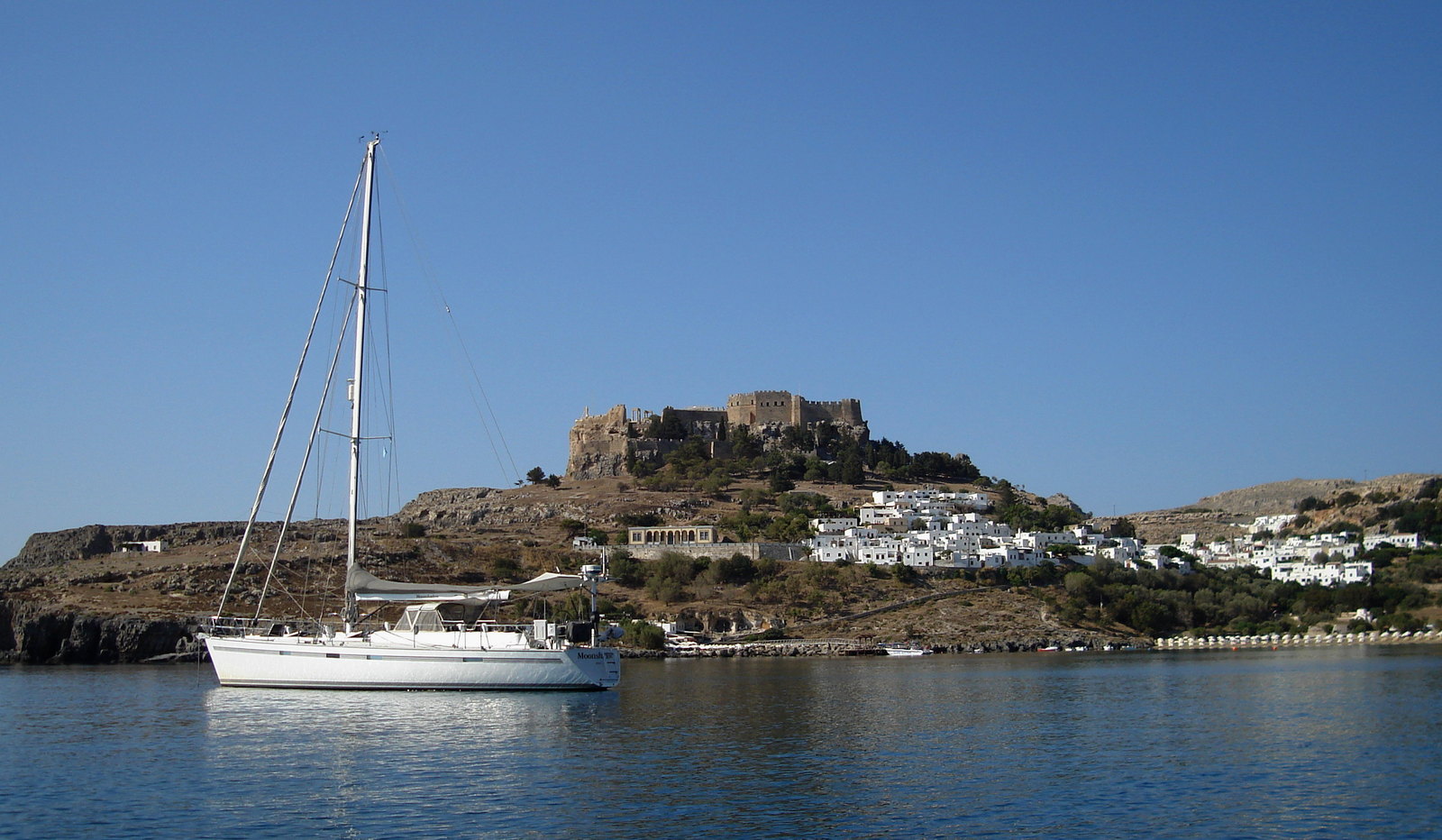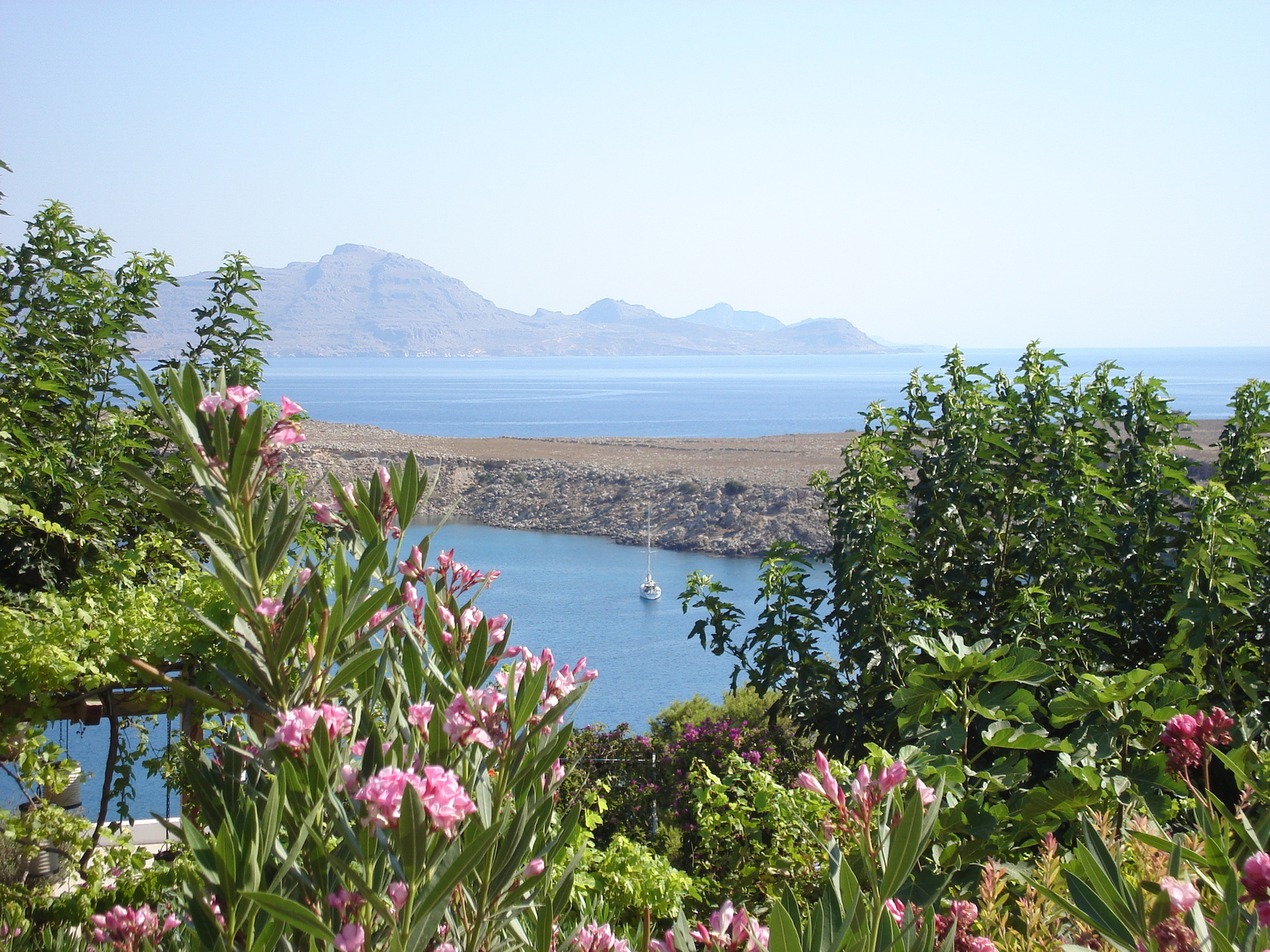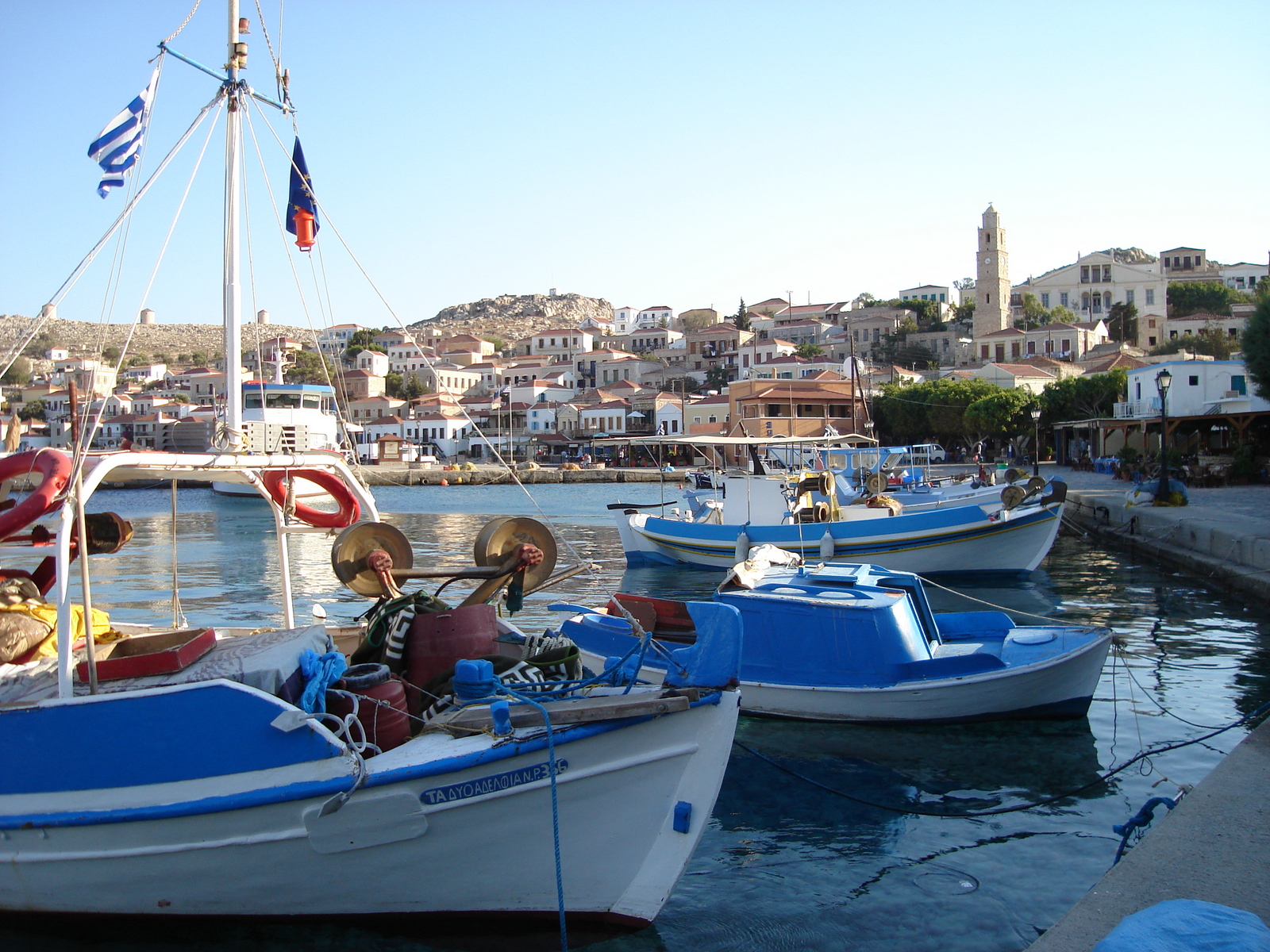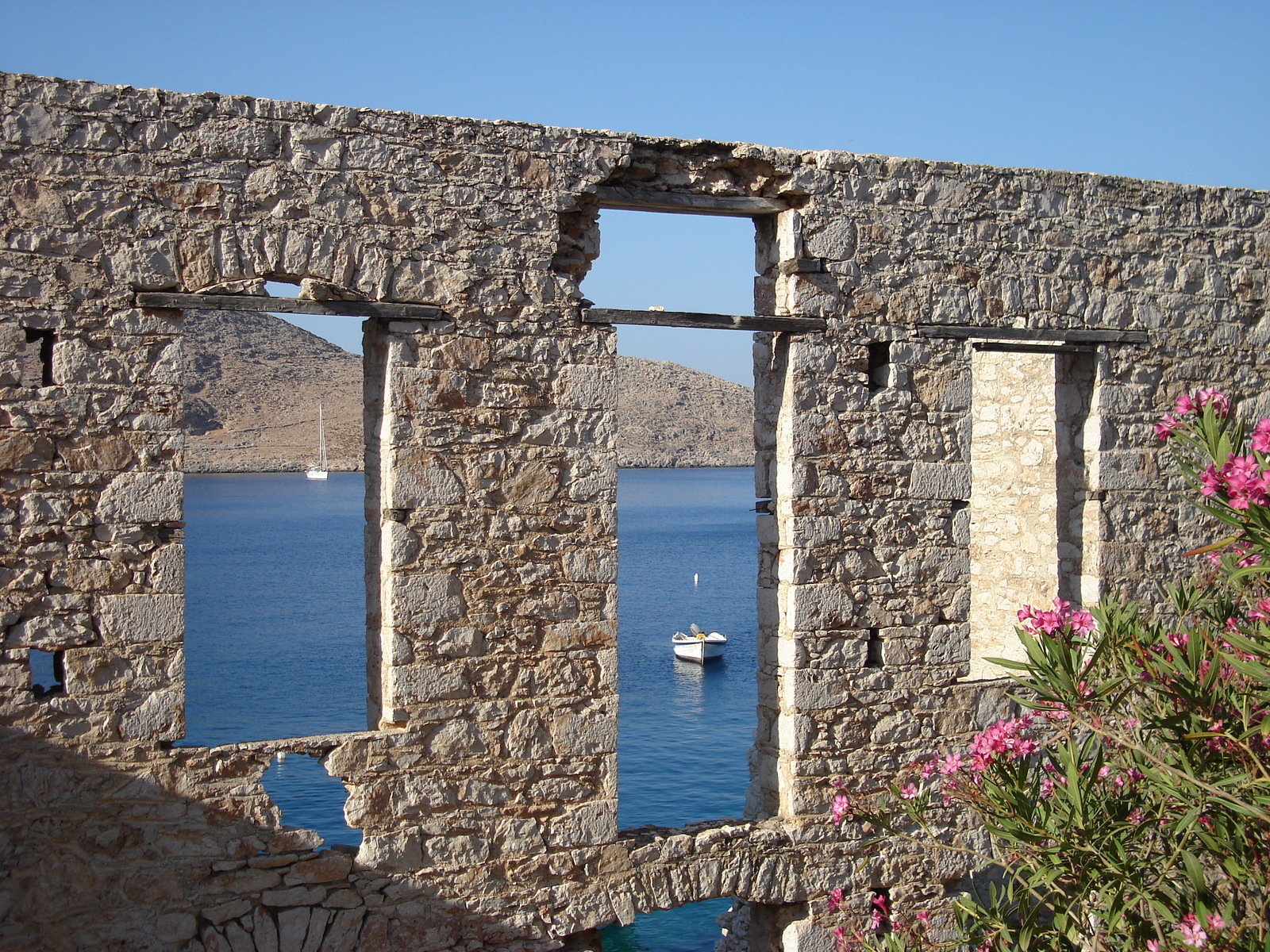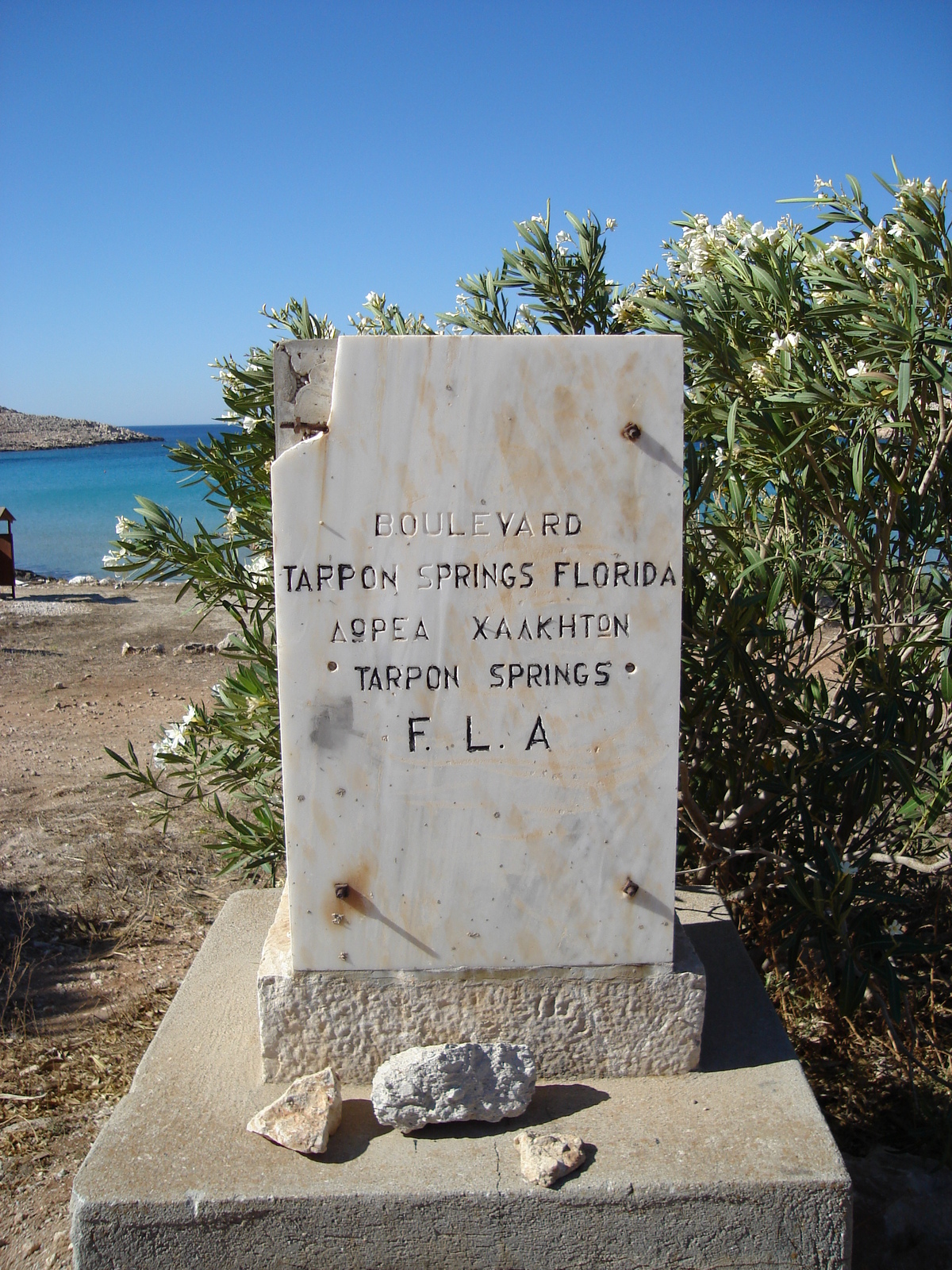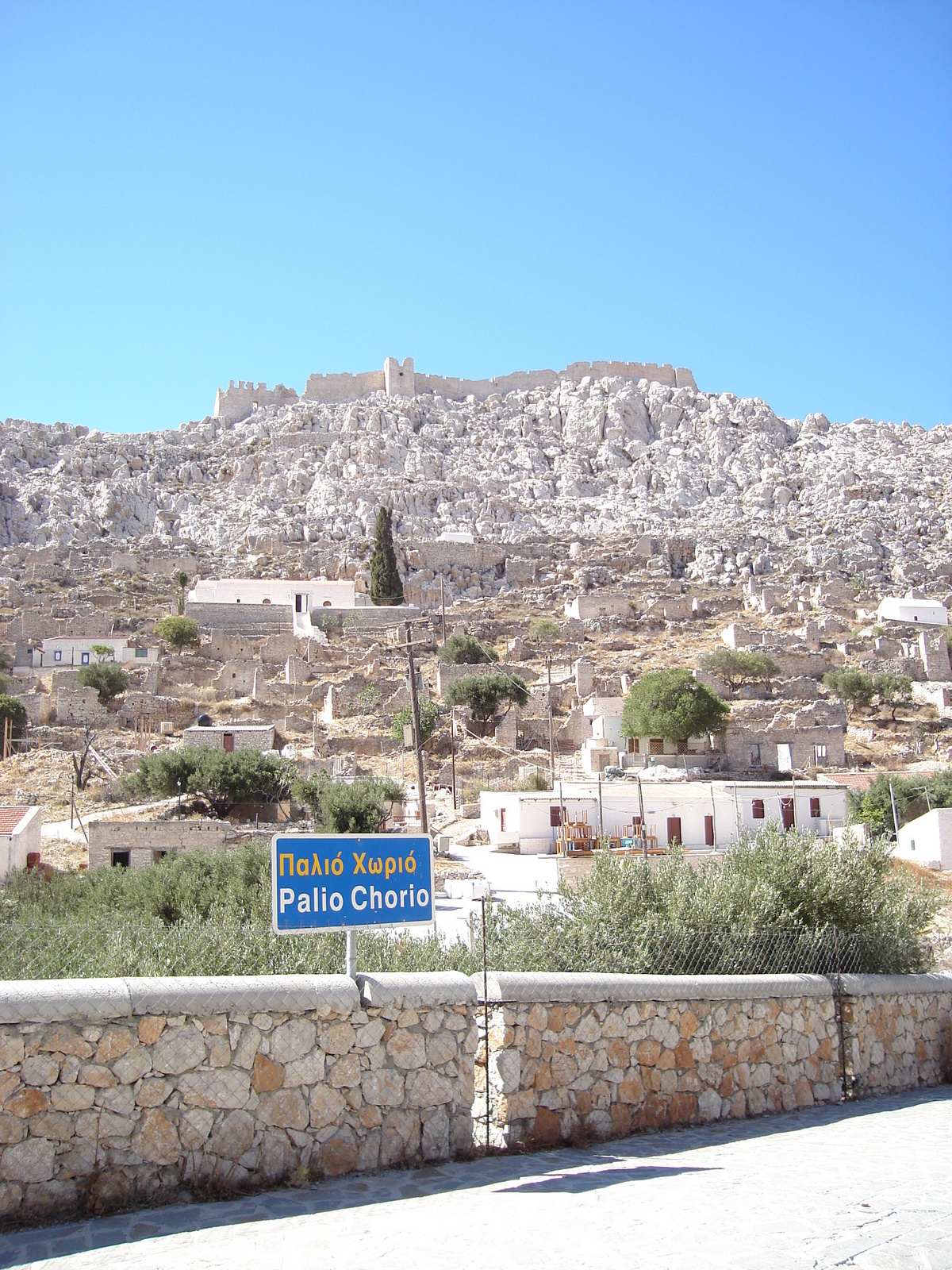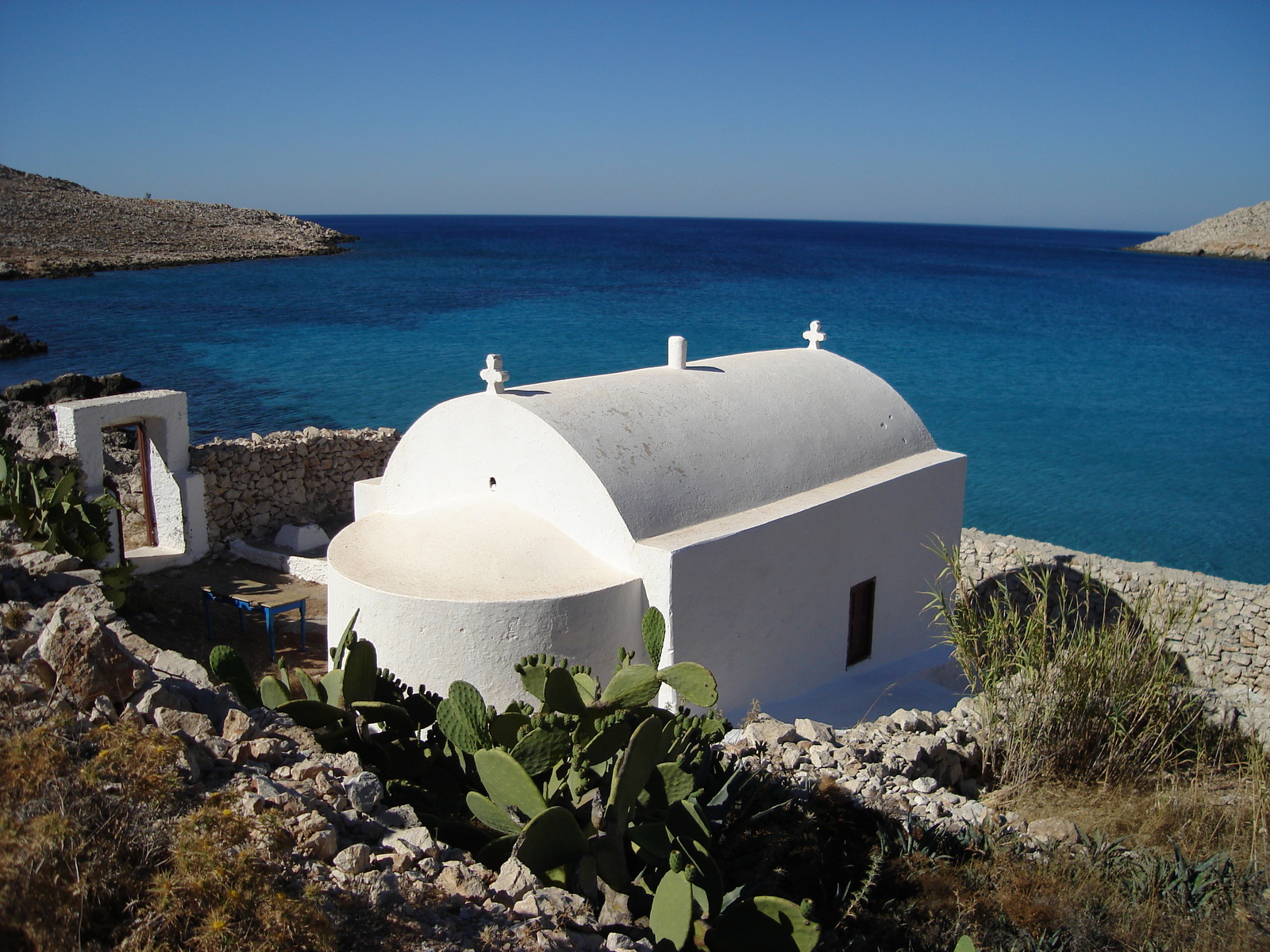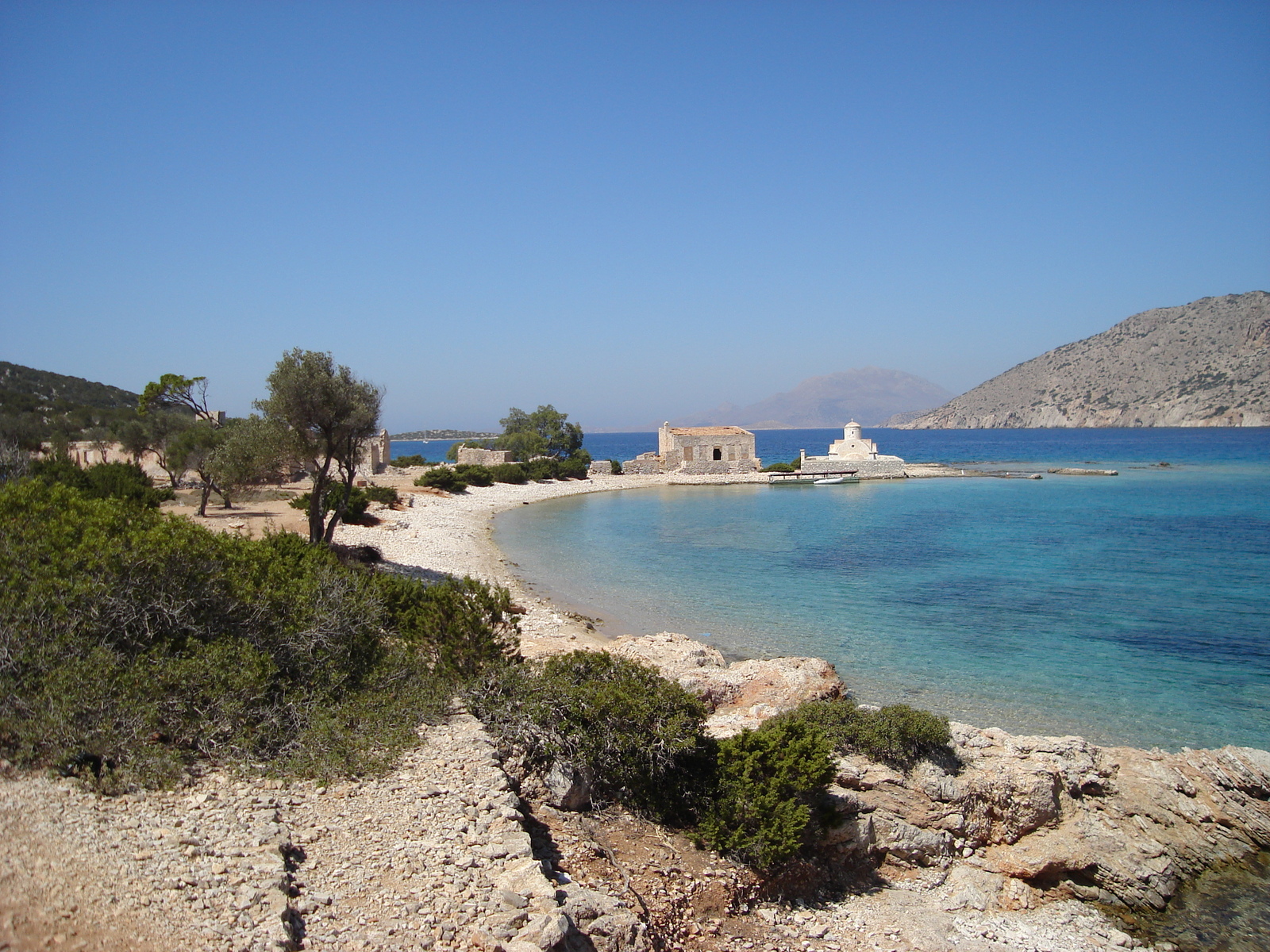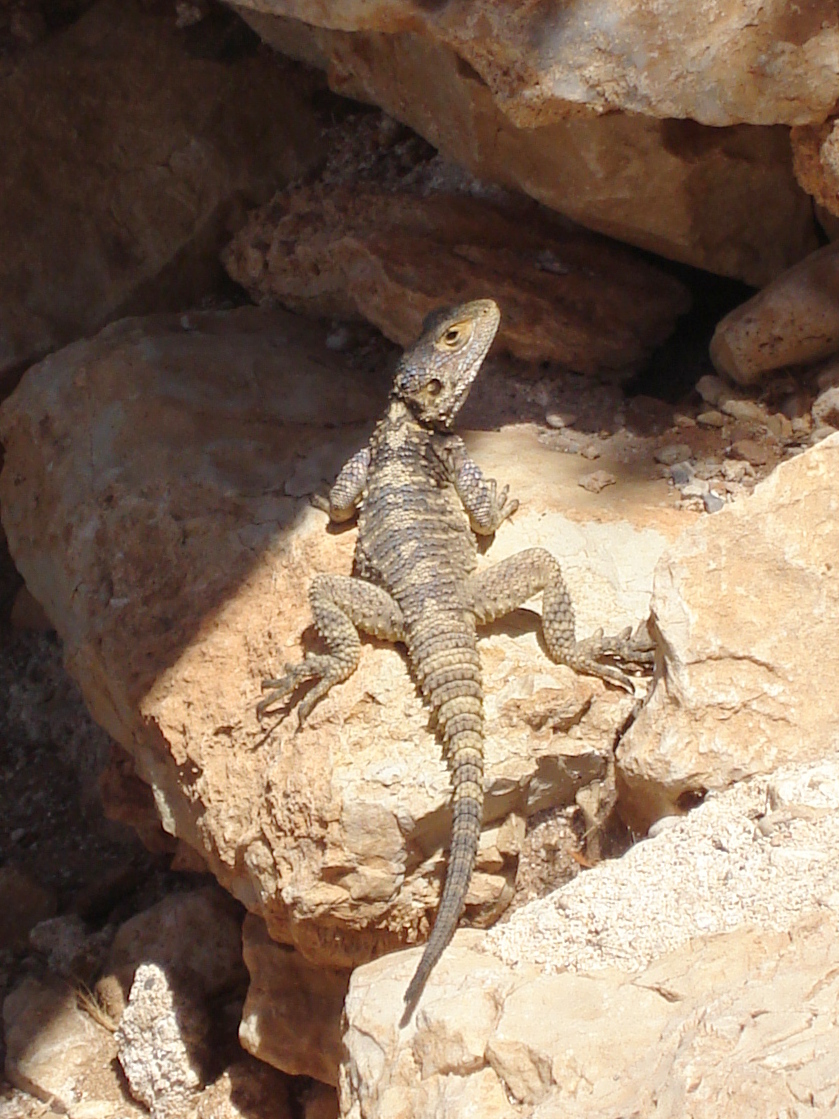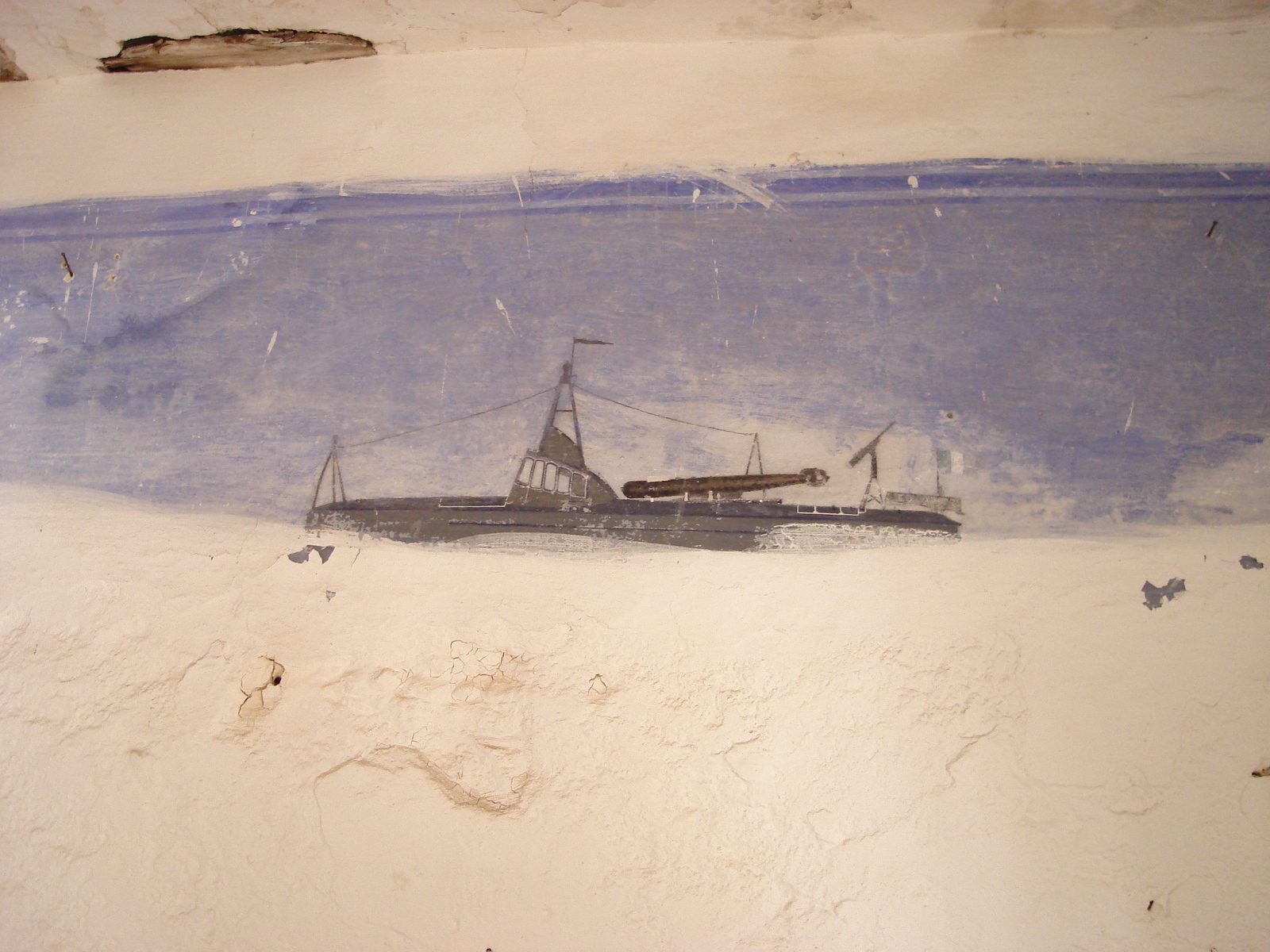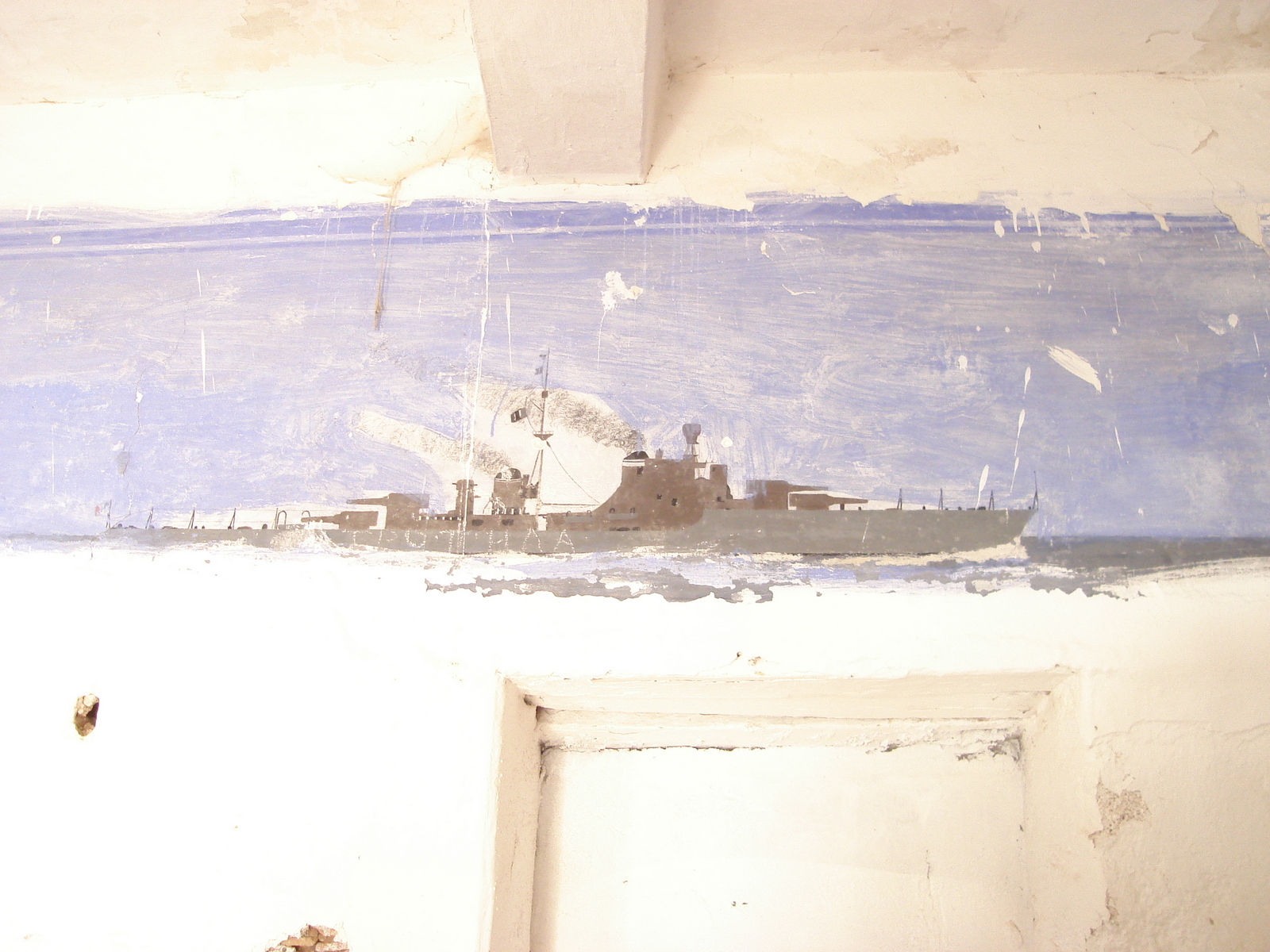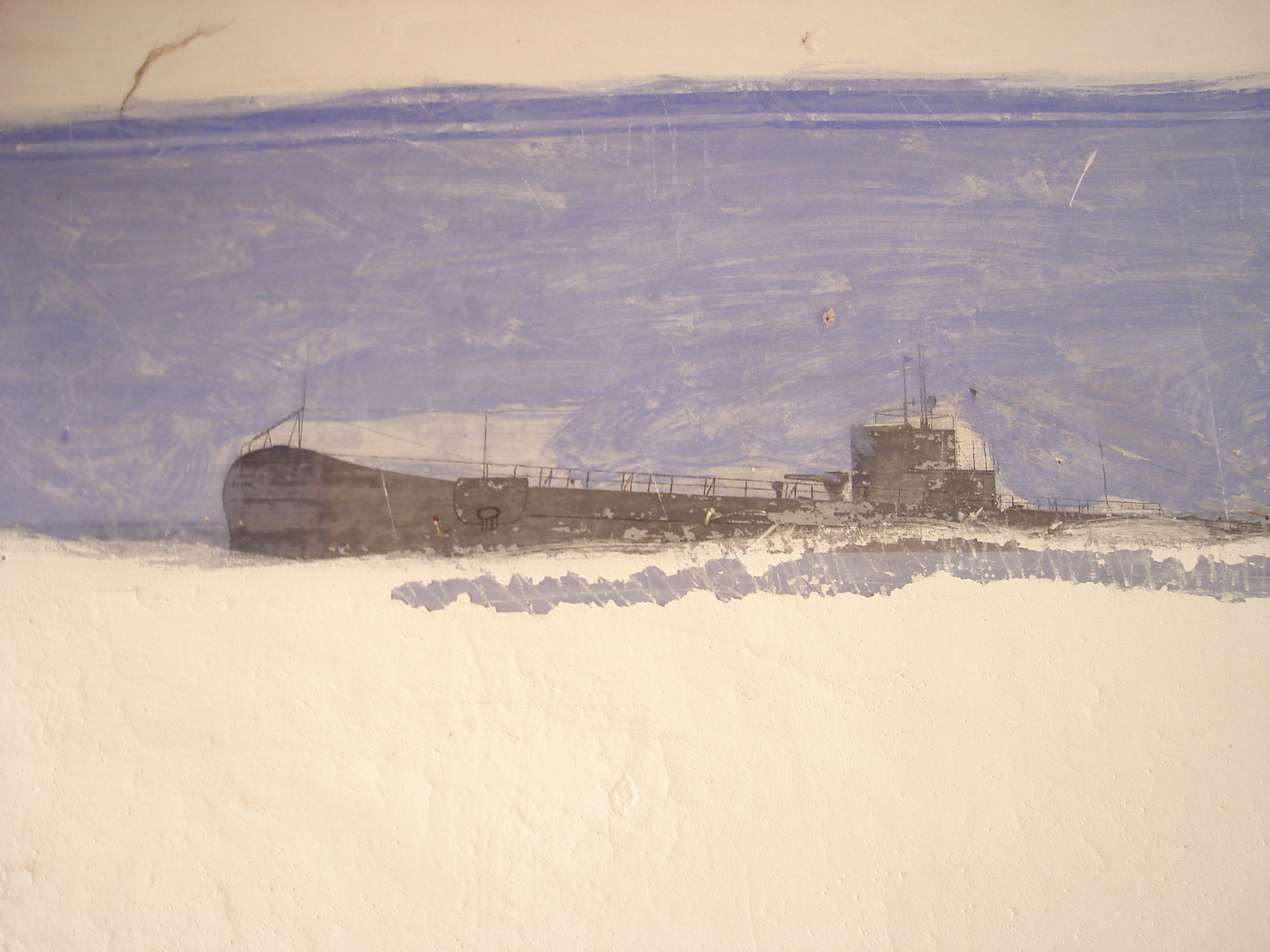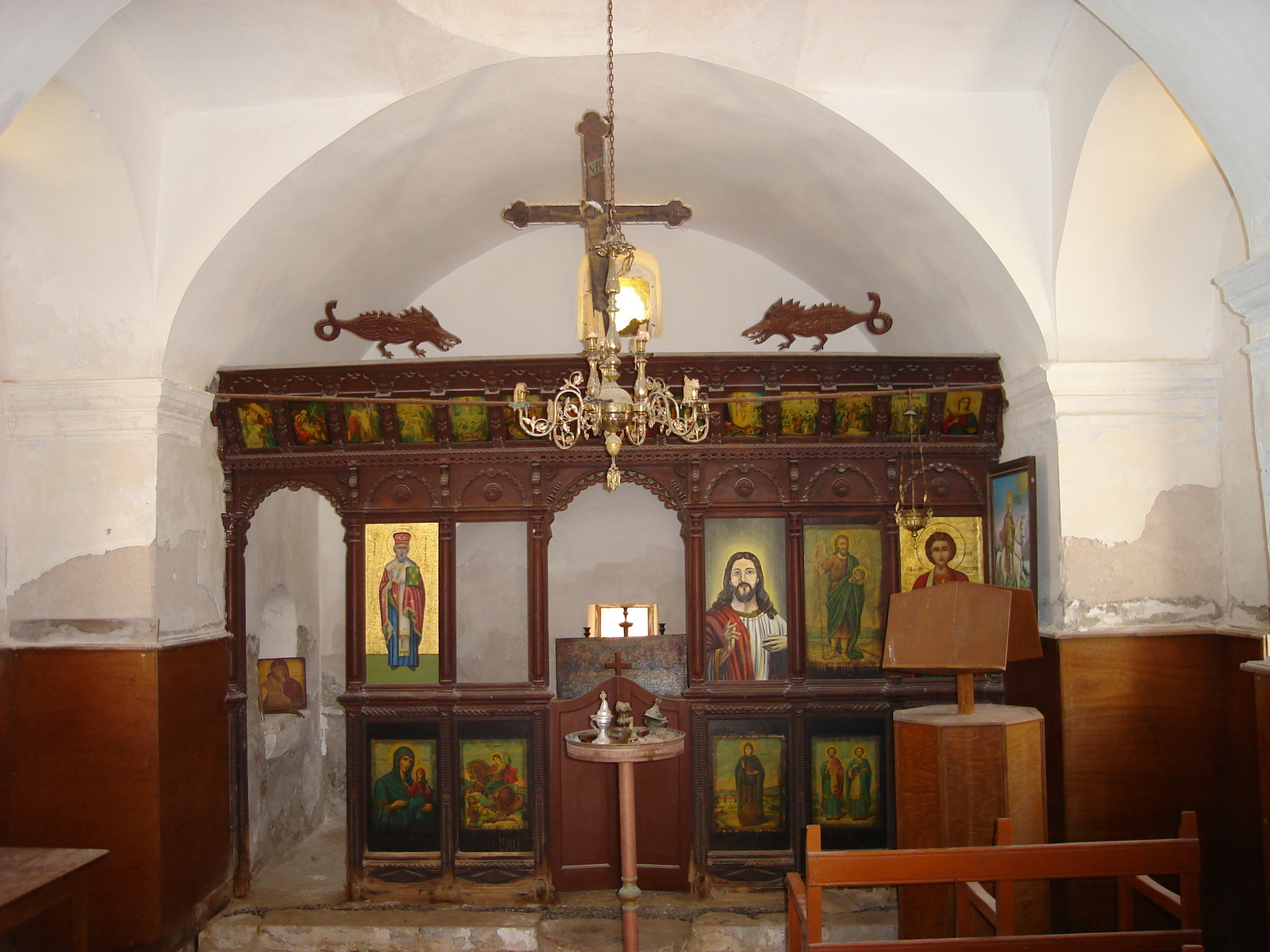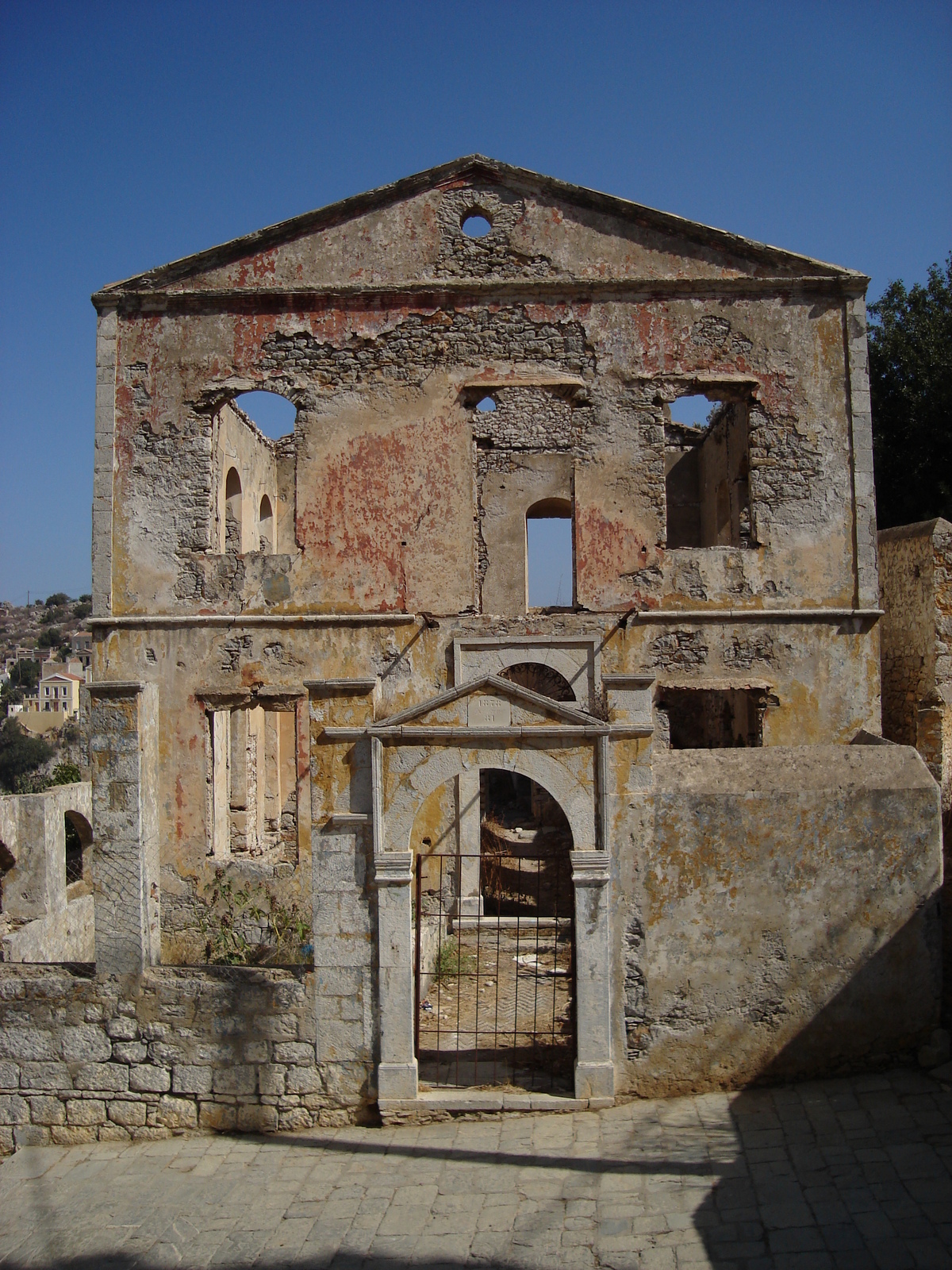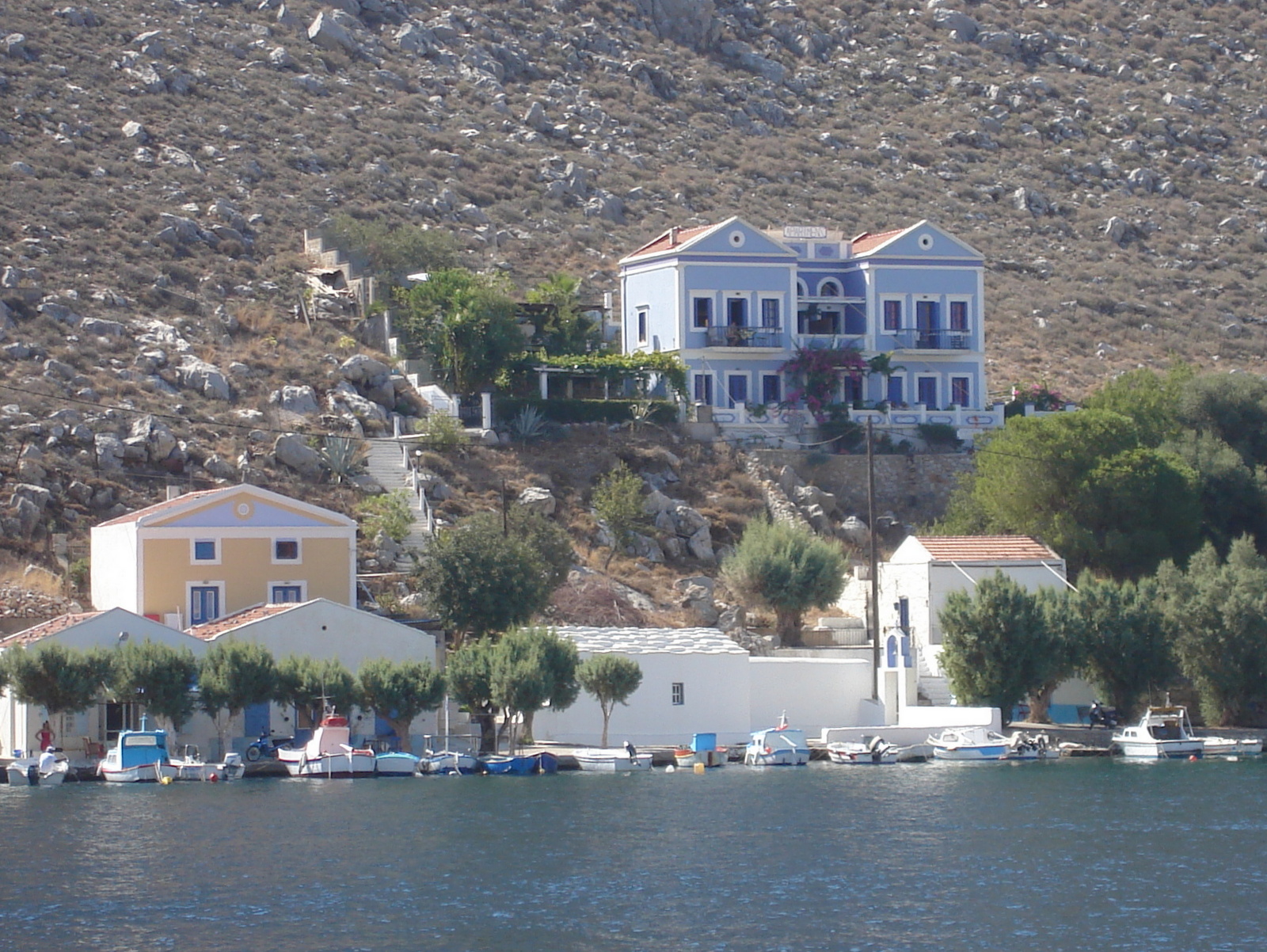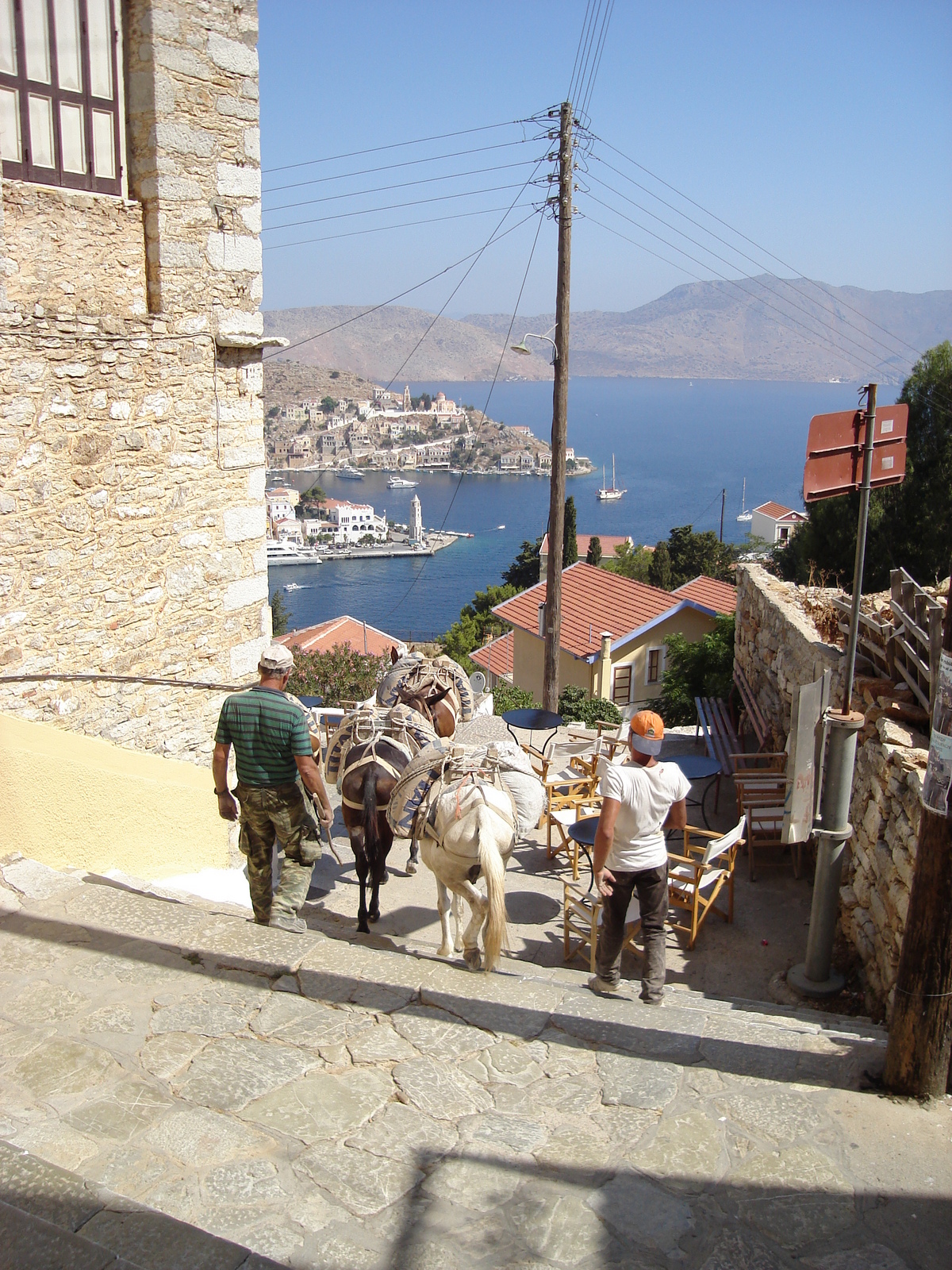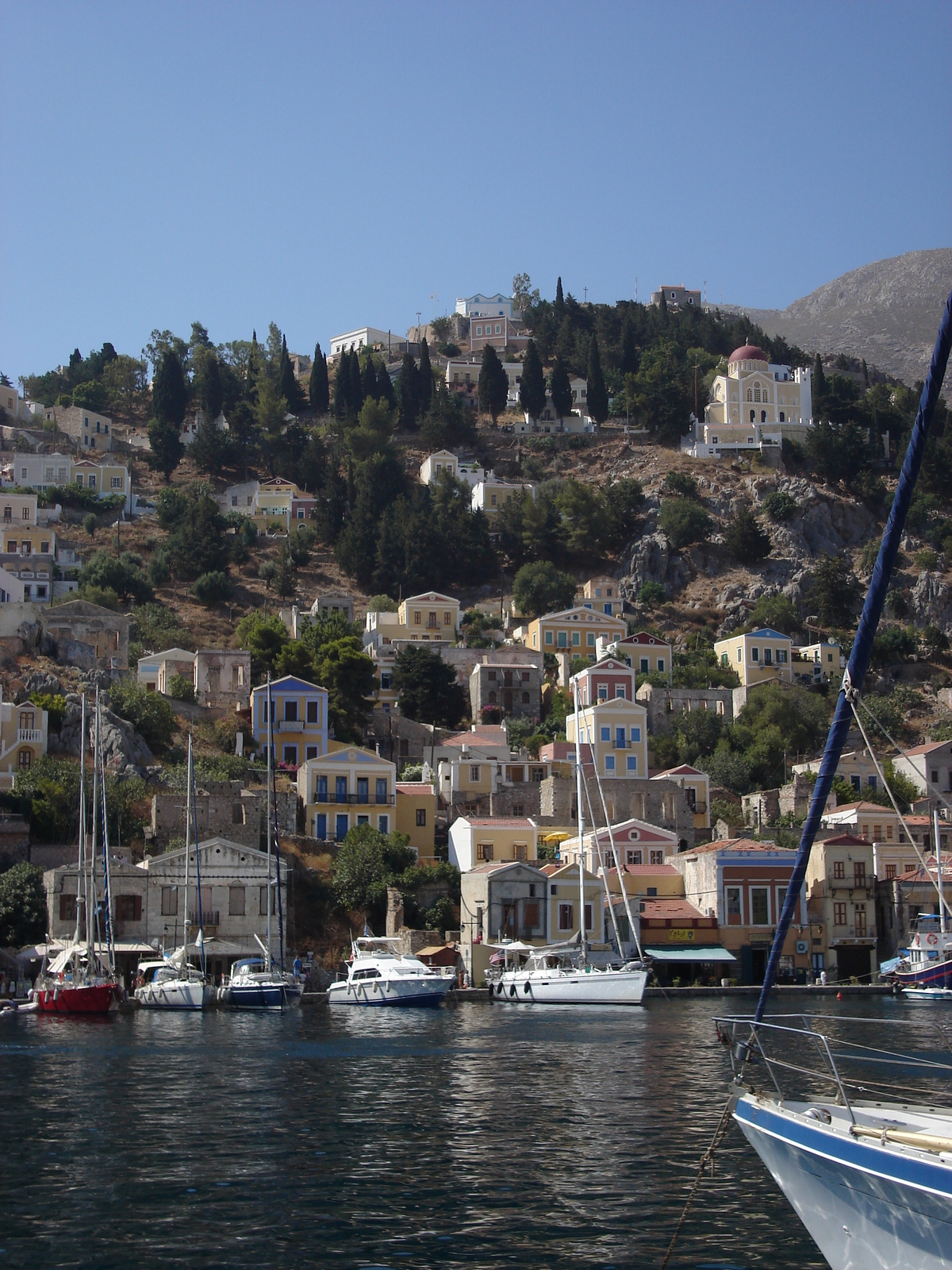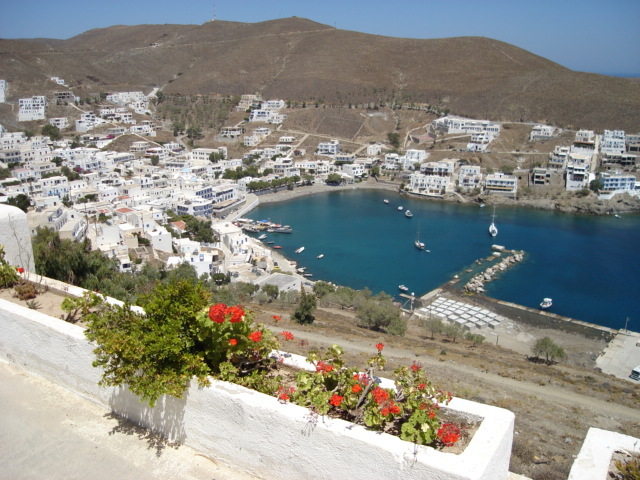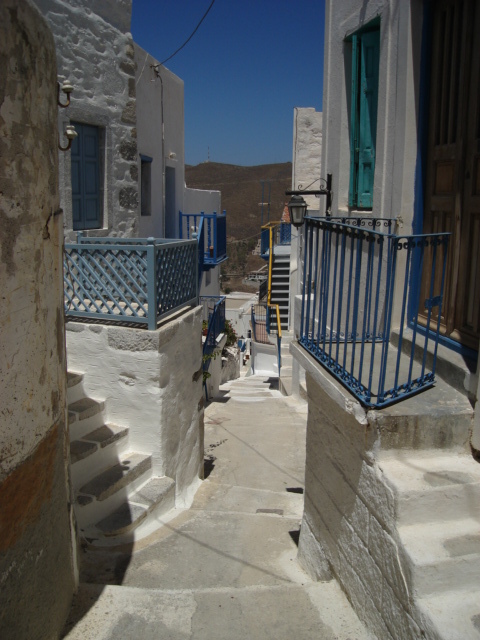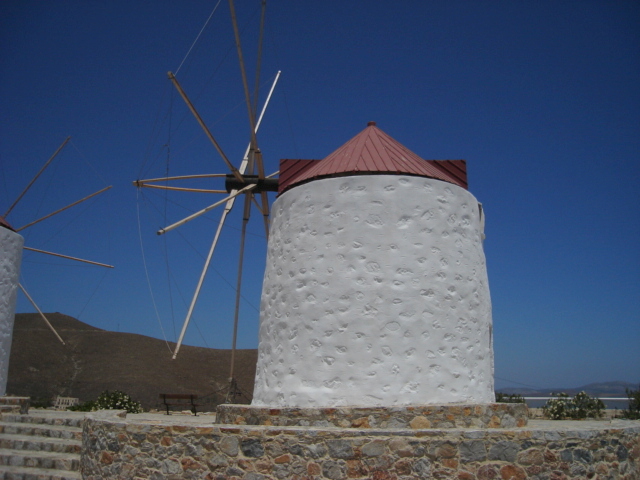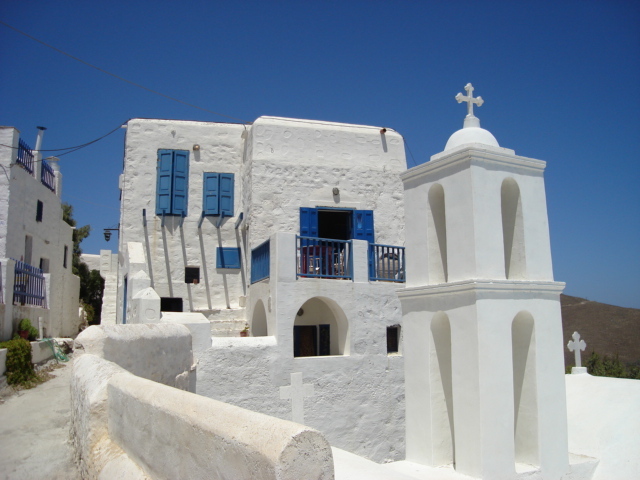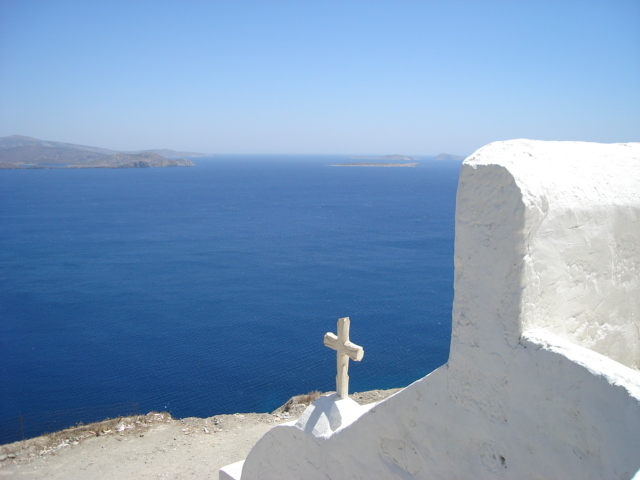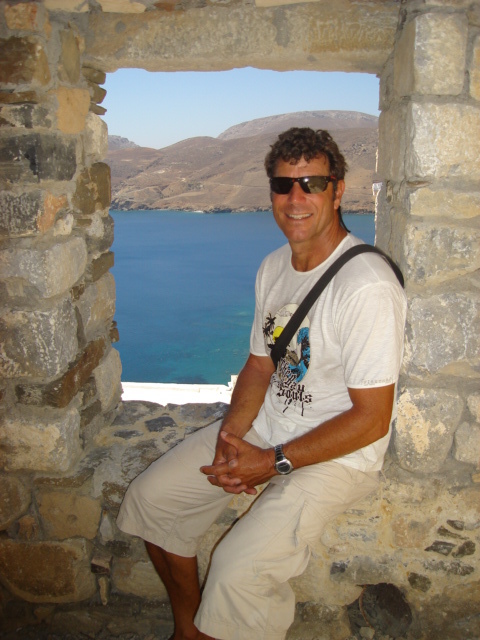We arrived at Mandráki Harbor on the Island of Ródhos on 26 July after a lumpy overnight motor-sail from Paphos in Cyprus. Ródhos is one of the easternmost of the Greek Isles and the largest in the Dodecanese, the group of twelve islands furthest southeast from mainland Greece and hugging the southwest coast of Turkey. Remnants of Ródhos’ tumultuous history as a strategic eastern Mediterranean stronghold made it a very interesting place to begin our Greek sojourn.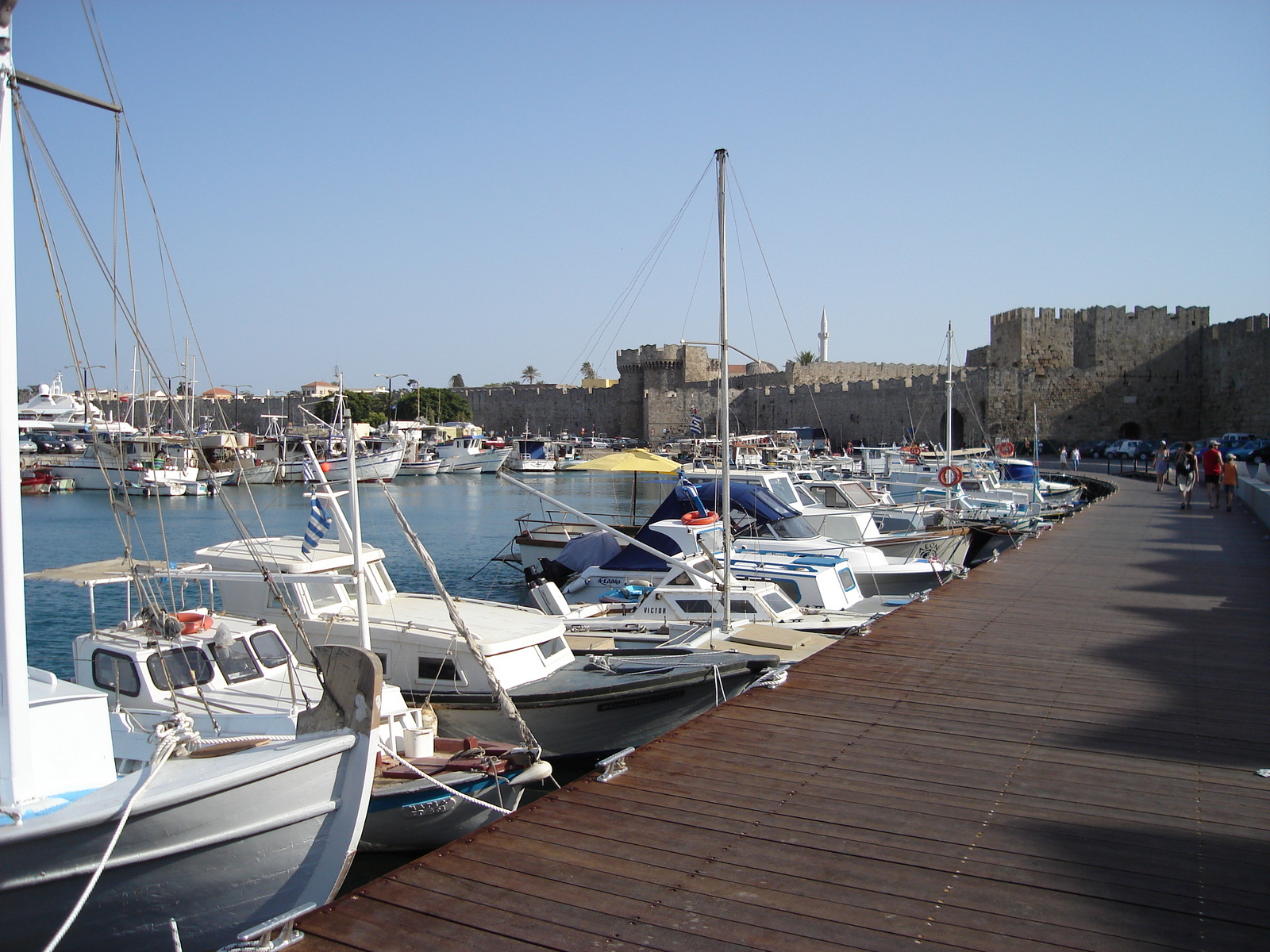
Mandraki Harbour
Contact with the Harbormaster at Mandráki had eluded us and we refused to pay an agent the staggering sum of €200 just to organize a berth for us. As we arrived, our radio and cell phone calls continued to go unanswered and after a cruise around the harbor it became apparent that a space to med-moor Moonshadow was just not available. We gave up on the marina and were fortunate to find a suitable anchorage about a mile southeast in Akandia Harbor. Protection was pretty good, there was an excellent dinghy landing on a small stretch of beach a hundred meters from the boat, and across the street was a gate to the medieval “Old Town” of Ródhos. We later discovered there were also grocery stores and chandleries within steps of the dinghy landing beach. I suppose this was a stroke of beginner’s luck.
After reading the Noonsite web site on Greece and The Greek Waters Pilot, we fully expected check-in formalities to be expensive, time consuming and fraught with bureaucratic b. s. Our expectations were quickly erased as we were warmly greeted by young, professional, polite and efficient officials in both the Greek Customs and Immigration offices located in the middle of the harbor. Paperwork took only a few minutes in each, and Customs issued us a “Transit Log,” sort of like a visiting yacht’s passport, good for six months and to be presented and stamped at each port we visited in Greece. Cost: €30. We walked to the other side of the harbor and made our last stop of the check-in process with the Port Police who signed and stamped our transit log and collected a one-time fee for checking into the country of €15. The duty officer briefly explained the formalities process for yachts visiting Greece. Less than one our later and with no hassles we were officially checked in, just in time to watch the America’s Cup race 3, scheduled for 1600 hours local time which ended up being abandoned due to lack of wind. All of that hurrying, so that we could just end up waiting.
We were enjoying having shifted from delivery mode into cruising mode again. It had been quite awhile since we had time to relax, linger, and explore interesting new places without the constant time pressure to stay ahead of weather windows.
We spent another five days in Ródhos getting acquainted with Greece and exploring the incredibly preserved and restored medieval walled city. We spent many hours walking nearly every meter of the old town’s labyrinth of narrow cobbled streets and passageways, taking in the quaint old homes, shops, cafes, mosques, churches, and climbing the clock tower. We even found a small “bar street” where we could end the day with a happy hour drink at some trendy little spot while listening to some relaxing chillout music.
The old city has a labyrinth of narrow cobbled streets
The clock tower in the centre of the old walled city
A rooftop view of the walled city from the clock tower
An old Orthodox church in the walled city
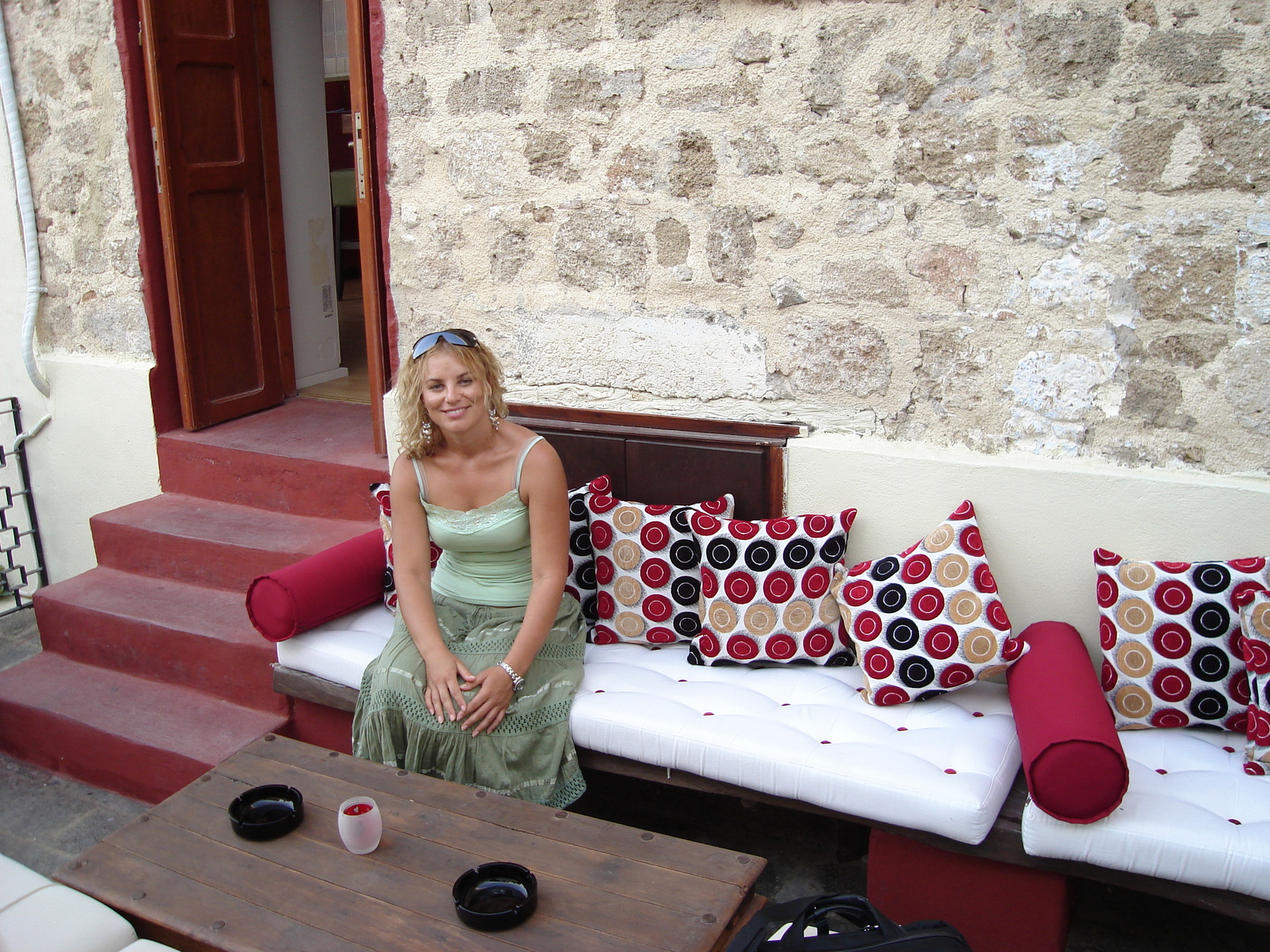
Happy hour at a rooftop bar
Our work schedule was pretty easy and our biggest projects were putting together another set of fenders for more protection when med-mooring (virtually all harbors and marinas in Greece are med mooring) and having an adapter fabricated so we could get our LPG cylinders filled in Europe. With a good chandlery and a machine shop in walking distance, these tasks were pretty easy.
After a week, we’d seen and done everything we wanted and needed in Ródhos Town, so we checked out and took a leisurely jaunt 25 miles down the east coast of the isle of Ródhos to the village of Líndos.
Cruising in the Aegean Sea is strongly influenced by the meltemi. This is the Turkish name for the northwest to northeast pressure gradient winds that affects the eastern Mediterranean. The meltemi is strongest in the summer months and often reaches into the 30 knot range, particularly in the central Aegean. It is lighter along the coast of Turkey and has a slight thermal component so it usually eases a bit at night offering some strategic options for boats wanting to cruise the Greek Isles. We found the best time to move north or west was early in the morning.
As we headed to Lindos, the meltemi kicked up to about 20+ knots from the northwest and in the flat waters in the lee of Ródhos we had some beautiful beam reach sailing at 10+ knots until the wind gradually died in the lee of a large mountain range forming the backbone of the island.
The picturesque village of Lindos sits on a steep hillside above a beautiful natural harbor whose lobes look as if they were once the calderas of a volcano. The parts that aren’t surrounded by steep cliffs are lined with beautiful sand beaches. There was plenty of room to anchor in the crystal clear water. We could easily see our anchor sitting on the bottom in 15 meters/50 feet. Most of the village of sugar cubed white buildings sits half way up the hillside from the beach. Perched on the top of the hill, on a rocky outcrop, is a large castle, one of many remnants in these islands of the Knights of St. John and their medieval crusades.
The village of Lindos
After checking in and out with the local port police and paying port dues of €0.88 cents (why bother?), we took a long walk around the town, avoiding the throngs of tourists in the shop areas and heading up higher to the narrow lanes lined with whitewashed homes and punctuated with splashes of color from bougainvillea and other flowers in blossom. Views out over the calm blue Med Sea were spectacular.
The following morning we headed ashore early and beat most of the day trippers to the castle and acropolis on the top of the hill. We had a wander around the grounds, took in the spectacular views and got away before the crowds arrived. On the way out, there was a queue a hundred meters long just to purchase entry tickets!
A view from acropolis of Lindos
We spent a few more hours wandering around the village of Líndos that morning and that evening had dinner at an excellent little café called Mavrikos that was once the haunt of the likes of Jacqueline Onassis and other who’s who of Europe. It is touted as one of the ten best restaurants in Greece and it was certainly the best meal we’d had in the country so far.
Three days of wandering around the picturesque village of Lindos was the perfect amount of time for us, so we weighed anchor and headed around the south end of Ródhos Island and then north to the old sponge-fishing village of Emborios on the island of Khálki.
The fishing village of Emborios
Compared to Rodos, Khálki receives much less tourism, so it is more rustic, quiet and laid back. Quite a few of the old homes still lay in ruin, having been abandoned after the decline of the sponge fishing industry. Some of the homes appear to be original, while a few are being beautifully restored, probably by outsiders looking for a quiet getaway. In typical Greek fashion, nothing happens to quickly or on too large of a scale.
Some of the old homes have yet to be renovated after war damage
After obtaining some poor directions, we spent a half an hour wandering around the village looking for the Port Police office and finally found it after a scenic but circuitous walk through the narrow streets and steps of Emborios. The port policeman quickly stamped our transit log but was too busy to be bothered collecting the €0.88 port dues and writing up a receipt.
A fisherman shows off his catch
We had dinner at an excellent little pizzeria situated on the waterfront. The bread they served with our appetizers had an uncanny resemblance to San Francisco sourdough. We bought some more at the local bakery the next day and the baker told us that it is made with a special yoghurt culture and can only be found on the island of Khálki.
Khalki has ties to Tarpon Springs, Florida
We were looking to stretch our legs a bit, so the day after we arrived, we took a walk about 3 kilometers inland to the “pirate-safe” village of Horió, which appeared to be all but abandoned. In its day, it sat up high enough for the inhabitants to see any approaching pirate ships, giving them ample time to whisk the women and valuables off to the safety of the castle perched on the mountain above. We found the path, not much more than a goat track, to the castle and climbed up there to enjoy some spectacular panoramic views of the Mediterranean and a few of the surrounding islands.
The village of Horio
Enjoying the view from the top of Horio
A small Orthodox church along the waterfront
That evening a short and sudden gale blew through, causing anchors to drag and boats to shift. We were fortunate to make it through with no dramas but I went out to help a Turkish man get re-anchored after I saw him single-handedly chasing his unattended yacht in his dinghy as it dragged anchor across the harbor. I reckoned he would appreciate another set of hands, which he did. We got his yacht anchored again, made friends and planned to catch up when we got to Turkey. The next morning we moved a short way to the neighboring island of Alimiá.
Dingy landing at the abandoned village at Alimia
The only inhabitant we could find on Alimia
Alimiá appears to be permanently inhabited only by a few goats and sheep, but there is evidence in the ruins that some fishermen or other visitors from surrounding islands come and stay. Alimiá was an Italian military outpost in WWII and some of the rooms of the old buildings still bear evidence of this. In one room we saw paintings on the walls of some of the Italian warships of the era.
Paintings on the walls of Italian warships
We wandered around the ruins for a few hours wondering what life might have been like. Some of the “homes” would have been scarcely more than caves. Interestingly, the two Orthodox churches in the village were both unlocked and appeared as if they were still in regular use and some of the homes had furnishings, cookware, etc. and were left unlocked.
Inside the Orthodox church at Alimia
The next morning in light airs, we motored northwest about 28nm to the Island of Sými, which is less than five miles off the coast of Turkey. Sými is a dry and rocky island with deep indentations on its steep-to coastline, forming some rather striking fjords.
Local fishing boats at the head of the harbour in Symi
Sými town was once a wealthy sponge-fishing and ship-building community and many of the old mansions clinging to the steep hillsides surrounding the harbor are romantic reminders of its glory days. Some are literally ruined shells, while others have been lovingly restored to their original beauty, both as private residences and as boutique hotels. Looking down on the village and harbor from an elevated position, Sými bears a strong resemblance to the beautiful little port of Portofino in Italy.
Tourism is restrained on Sými by the lack of fresh water on the island, and most of it has to be shipped in by tanker from Ródhos. For visiting yachts water is charged out at €15 per metric ton so it’s no place to give the boat a long bubble bath! Many visitors come in by ferry for the day, so the mornings and evenings are pleasantly quiet around town, and the hot mid-days are good for staying on board and tending to writing, boat projects and perhaps an afternoon nap.
Sými also seems to be on the charter boat route, so there were a lot of comings and goings each day. Because the harbor is so small and narrow, and boats med moor on both sides, fouled anchors are a regular occurrence. On a couple of occasions I had to go out in the dinghy and help some charterers unfoul two or three anchors, and show them how to get free of my rode without picking up or dislodging my anchor. Many of the yachties sat out on the bows of their boats and watched the morning show over their cups of coffee.
We enjoyed exploring the maze of streets, walkways and stairways winding between the old buildings clinging to the steep hillsides. Quite a few of the homes and ruins in the upper part of the village date back to medieval times. Most of the streets have steps or are quite narrow, so very few can accommodate motor vehicles. Mules and horses are used to move heavy building materials to renovation projects. These animals don’t seem to pay much attention to pedestrians, so we found it necessary to pop into a doorway or down a side street to avoid being squashed or trampled. Reaching the top of the built up areas, we were rewarded by many pleasant outlooks over the harbor, the island and the surrounding Greek Isles and Turkish coast.
A number of grand old homes still lay in ruin
Others have been sympathetically restored
Donkeys carry building materials through the steep and narrow streets
Sými appears to cater to up market visitors and ex-pats, so there is no shortage of excellent tavernas, restaurants, cafes, bakeries, bars and discos from which to choose. We sampled a few places and enjoyed some excellent meals and locally baked items.
Along with a plethora of tourist shops selling sea sponges (mostly from other parts of the world) and the usual trinkets were a couple of small but well-stocked chandleries. The better stocked of the two had a few bits and pieces that we needed, but it was nearly impossible to find anything without help from the proprietor. The shop was not much larger than a walk-in closet and so crammed with stuff that it was nearly impossible just to move around inside. The floor-to-ceiling shelves were haphazardly stacked with boxes and loose items, and other items were strung up and hung from hooks in the ceiling, not to mention all the items stacked up on display out on the walkway during opening hours.
A handsome little fishing boat
A couple of days into our stay, the quay was converged upon by a flotilla of “beach balls.” (See the “Cruiser’s Glossary”) This group of ten or so 40-ish footers was told by the “flotilla captain” to run for cover a day earlier than scheduled in Sými as there was a gale coming. It is always entertaining to watch all these relatively inexperienced crews bring the boats in (not that we don’t provide some good entertainment for other boats from time to time as we anchor or moor). Merima pointed out to a couple boats next to us that their masts were in line and might bang into each other as it got very rolly when the big ferries maneuvered in the harbor. The response from the cocky Australian skipper of one of the boats (who had just backed up to the wall at no less than 6 knots, then used full forward throttle to stop the boat) was, “that’s the great thing about charter boats, they’re not ours so we don’t have to worry about things like that.” Ooooooo-kaaay we thought, we can see the sort of mentality with which we’re dealing. Boat owners of the world might want to keep this attitude in mind the next time you consider putting your beloved boat into a charter fleet.
Moonshadow is med-moored amongst the mostly charter boat fleet
After five lovely days in Sými, we headed west to visit the volcanic island of Nísiros. The caldera in the center of the island is meant to be one of the “don’t miss” things in Greece. Once we were out of the lee of the Dorian Promontory, the long, narrow peninsula extending west from the Turkish coast, the meltemi kicked in with about 20-25 knots on our beam, giving us a fast and wet ride. Unfortunately, both of the small harbors on Nísiros are on the north side, fully exposed to wind and swell, so we weren’t too keen to try our luck at med mooring in those conditions. Plan B (we’ve made it standard procedure to always have a plan B when cruising the Greek Isles) was to head a couple miles north to the island of Yialí and anchor in its lee for the evening and then have another look at Nísiros in the morning in case conditions had improved.
Yialí proved to be a decent overnight spot to anchor if the island itself is not aesthetically pleasing. There isn’t much on shore but a pumice quarry, but the protection and holding were excellent. We tried again at Nísiros again the next morning but it still looked like there was a bit too much surge coming into the harbor for safe and comfortable med mooring. We took advantage of the fresh meltemi again and had a swift beam reach to Astipálaia, about 38 miles due west.
Astipálaia has a very snug harbor on its east coast off the village of Skála offering reasonable protection. We anchored just outside the harbor in a comfortable spot across the bay from the commercial wharf. I went ashore to check in with the Port Police. He casually waved me off and said I didn’t need to bother, but asked me to move Moonshadow into the harbor to keep clear of the ferry arriving the next morning at 0900.
Moonshadow (centre right) at anchor in the snug harbour at Astipalaia
After three attempts we were finally able to get positioned just right, allowing us room to swing in the north to northwest meltemi and stay clear of a jetty, another anchored yacht, the rocky shoreline and a couple of local fishing boats. Sometimes I feel like we’re trying to maneuver a Cadillac on icy pavement into a parking space designed for a motorcycle!
We headed in to shore to celebrate our success with a meal out at a lovely little waterfront taverna about 100 meters from Moonshadow. The owner came out to the beach to greet us and helped us pull the dinghy ashore. We enjoyed a romantic meal of local specialties at a table set up right out on the sand beach.
Skála was another “pirate safe” village and has the ruins of a castle perched on the top of a hill overlooking the village, port and sea. We had a walk up to the castle and noticed that as we got further up the hill, the homes appeared to date back further and further. Some of the homes surrounding the castle, still in use today, were quite primitive, with stone walls and roofs made from earth supported by sticks. Most had whitewashed exteriors accentuated with doors and window frames enameled in various hues of blue.
Narrow streets in the village of Skala
Windmills on the ridge
The castle at the top of the hill
Views out over the Med from the castle
The meltemi had been generally quite light for us, so we decided to tempt fate a bit venture further west a bit into the Cyclades Group out in the central Aegean Sea and visit a couple of the more popular islands like Santorini and Míkonos.

